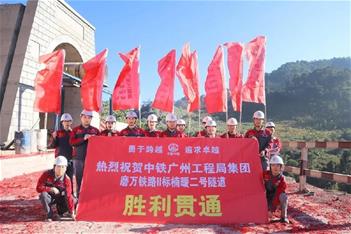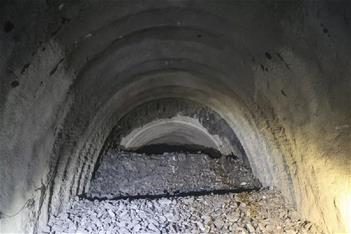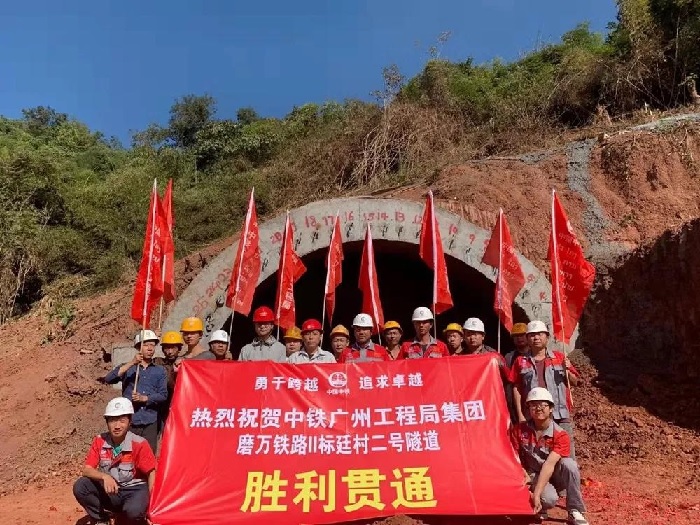Press release - At present, the construction of the tunnels of the China-Laos Railway has entered the dry season. There are continuous reports of tunnel breakthroughs. The companies involved in the project worked hard in December to achieve the completion of several tunnels and the control project of the entire line.
The China-Laos railway, with an operating speed of 160 km/h, has holed through 50 of its 76 tunnels with a total length of 198 km. The 414.332 km single track China-Laos railway project started in December 2016 and it’s inauguration is scheduled in December 2021.
On December 27, 2019 the 9,384 m Sencun n.2 railway tunnel, south to Luang Prabang, 170 km north of capital Vientiane, was drilled through by the Chinese companies PowerChina Sinohydro Bureau 3 Co LTD (Sinohydro 3) and Sinohydro 14 (click here for a video).
The Sencun n.2 tunnel, the longest on the China-Laos railway, crosses the provincial border of Luang Prabang and Vientiane in the tropical mountains, with steep terrain, complex geology, abundant groundwater, and difficult construction and transportation conditions. The Sencun n.2 tunnel construction started March 15, 2017. The monthly record in the advancement was 245.8-m.
On December 18, 2019 with 74 days ahead of schedule the China Railway Guangzhou Engineering Group (Crec-Gz) completed the 3,376 m Muangxay n.1 tunnel on the China-Laos Railway, with a 192 m difference under an undulating terrain.The high ground temperature in the tunnel, reaching 37 degrees Celsius, created harsh conditions for the Chinese engineering team. It was the 49th tunnel.
On December 14, 2019, the China-Laos Railway Tingcun n. 1 tunnel, constructed by the China Railway Guangzhou Engineering Group (Crec-Gz) went through smoothly. This is the 48th tunnel that runs through the entire line.

On December 7, 2019 the Nam Nouan n. 2 tunnel built by the China Railway Guangzhou Engineering Group (Crec-Gz) was successfully completed. It’s the 47th tunnel that runs through the entire railway line. The 2136 m Nam Nouan n. 2 tunnel passes through a unfavorable geological conditions such as bias, shallow burial, etc, reaching a minimum depth of only 13 m. The construction risk is high, and the proportion of weak surrounding rocks in the tunnel is large, and the Grade IV and V surrounding rocks are as high as 95.3%. The Nam Nouan n. 2 tunnel construction started in May 2017.

On December 5, 2019 the PowerChina Sinohydro Bureau 3 Co Ltd (Sinohydro 3) successfully completed the construction of Sarabatur/Sarabatta n.1 tunnel, located in Xiangen County, Luang Prabang Province. Except for the Salaba Station (double line), which is arranged into the tunnel at 698m, the rest are single lines.
The tunnel structure is a mid-alpine landform with large terrain fluctuations. The ground elevation is 430-760m. The lithology of the formation is mainly Carboniferous slate with sandstone, marl, gray slate, joint fractures, rock mass. The costruction started in October 2017.

On December 2, 2019 the PowerChina Sinohydro Bureau 3 Co Ltd (Sinohydro 3) completed construction of the Puya Village n.3 tunnel in northern Luang Prabang Province, 29 days ahead of schedule. The 1297 m tunnel -from km
195 + 452 to km 196 + 749 - has a 186 m maximum overburden and in the section from km196 + 270 to km196 + 300 a 15 min minimum overburden. The Puya Village tunnel n.3 is one of the high-risk tunnels on the whole line.
The tunnel is located in the Luang Prabang geological suture zone, with a geological structure extremely complicated. The tunnel structure belongs to low- and medium-mountain landforms. The construction of Puya Village n.3 tunnel started on June 20, 2018.
On November 30, 2019 the Tingcun n. 2 tunnel, 362 m long and built by China Railway Guangzhou Engineering Group (Crec-Gz), became the 43rd tunnel that the China-Laos Railway runs through. The tunnel is located in the mountainous area of Meng'a County, Udomsai Province.Its alignement is through complex geological conditions, with a 49-m maximum overburden.
On November 21, 2019 the 6,416-meter-long Dalong n.1 tunnel, whose construction started in April 2017, has been completed after 939 days by PowerChina Sinohydro Bureau 3 Co LTD (Sinohydro 3) .The Dalong n.1 tunnel belongs to a Class II risk tunnel. It is designed with Class III surrounding rock 1670m, Class IV surrounding rock 3790m, and Class V surrounding rock 956m.
On November 17, 2019 China Railway No. 8 Engineering Group (CREC-8) breakthought the 1,001-meter-long Huihan/Houay Han n.1 tunnel, 43 days ahead of schedule. The tunnel, located in the mountainous northern Laos, between the northern Lao city of Luang Prabang and the border between Laos and China, was the 41st tunnel completed on the China-Laos Railway.
Visit http://english.www.gov.cn/ and http://www.lcrc.ltd/news.html. 02/20.

